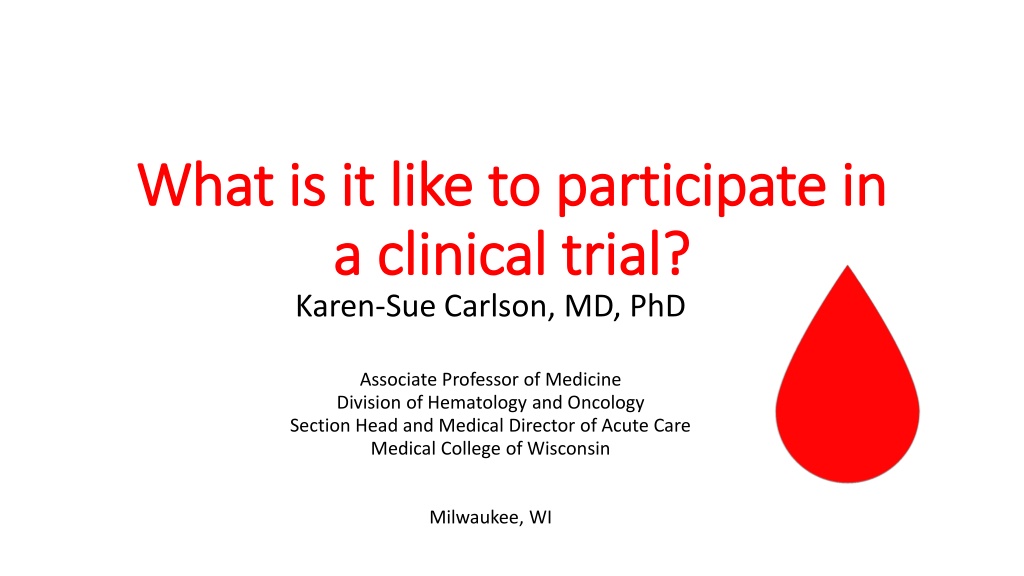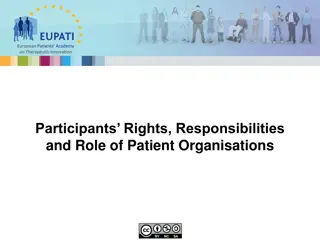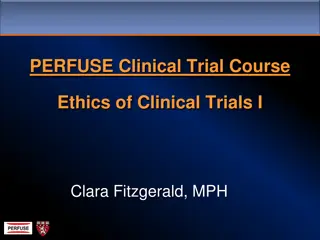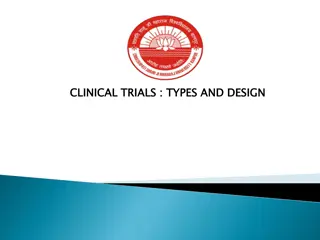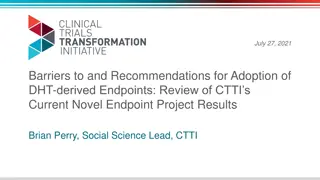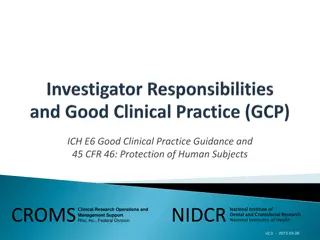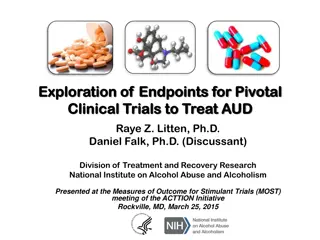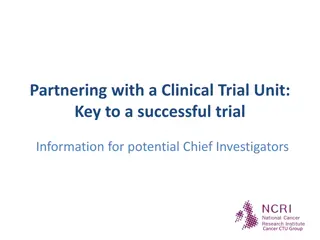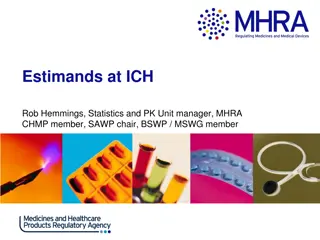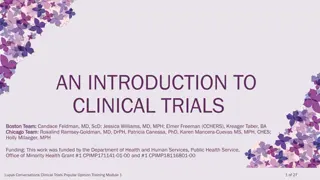Participating in Clinical Trials: What to Expect
Clinical trials are research studies where human subjects are assigned to interventions to evaluate health-related outcomes. Phases 1, 2, and 3 test safety, efficacy, and comparison to standard treatments. FDA regulates these trials to ensure public health.
Download Presentation

Please find below an Image/Link to download the presentation.
The content on the website is provided AS IS for your information and personal use only. It may not be sold, licensed, or shared on other websites without obtaining consent from the author.If you encounter any issues during the download, it is possible that the publisher has removed the file from their server.
You are allowed to download the files provided on this website for personal or commercial use, subject to the condition that they are used lawfully. All files are the property of their respective owners.
The content on the website is provided AS IS for your information and personal use only. It may not be sold, licensed, or shared on other websites without obtaining consent from the author.
E N D
Presentation Transcript
What is it like to participate in What is it like to participate in a clinical trial? a clinical trial? Karen-Sue Carlson, MD, PhD Associate Professor of Medicine Division of Hematology and Oncology Section Head and Medical Director of Acute Care Medical College of Wisconsin Milwaukee, WI
What are clinical trials? National Institutes of Health Definition (NIH): A research study in which one or more human subjects are prospectively assigned to one or more interventions to evaluate the effects of those interventions on health- related biomedical or behavior outcomes. Mechanistic Behavioral Exploratory or Development Other Clinical Trial Interventional Pilot or Feasibility Basic Experimental https://grants.nih.gov/policy/clinical-trials/definition.htm
Conflicts of Interest: No other formal disclosures but I regularly offer clinical trial participation to my patients.
What is the Phase of a clinical trial? Phase 1 clinical trial: The first step in testing a new treatment in humans. Tests safety, side effects, best dose, means of giving a treatment, or timing of a new treatment. Small number of patients, often those who have not been helped by other treatments. Phase 1 Phase 2 Phase 3 https://www.cancer.gov/publications/dictionaries
What is the Phase of a clinical trial? Phase 2 clinical trial: Tests whether a new treatment works for a certain disease. May also provide more information about the safety of a new treatment or how the treatment affects the body Phase 1 Phase 2 Phase 3 https://www.cancer.gov/publications/dictionaries
What is the Phase of a clinical trial? Phase 3 clinical trial: Tests how well a new treatment works and its safety in comparison to a standard therapy. Most trials move to phase 3 only after they meat the goals of phase 1 & 2 trials. Often include a large number of participants. Phase 1 Phase 2 Phase 3 https://www.cancer.gov/publications/dictionaries
How are clinical trials regulated? FDA = Food and Drug Administration An agency in the U.S. federal government whose mission is to protect public health by making sure that drugs, medical devices, and equipment are safe and effective. This group also ensures that food, cosmetics and nutritional supplements are safe and truthfully labeled. FDA IRB DSMB Good Clinical Practice https://www.cancer.gov/publications/dictionaries
How are clinical trials regulated? IRB = Institutional Review Board A group of scientists, doctors, clergy, and patient advocates that review and approve the detailed plan for a clinical trial. IRBs are meant to protect the people who take part in a clinical trial. Every trial is reviewed by an IRB before it begins. FDA IRB DSMB Good Clinical Practice https://www.cancer.gov/publications/dictionaries
How are clinical trials regulated? DSMB = Data and Safety Monitoring Board This is an impartial group that oversees a clinical trial and reviews the results to see if they are acceptable. This group determines whether a trial should be changed or closed. FDA IRB DSMB Good Clinical Practice https://www.cancer.gov/publications/dictionaries
How are clinical trials regulated? Good Clinical Practice An international set of guidelines that help to make sure that the results of a clinical trial are reliable and that patients are protected. Good Clinical Practice covers the way a clinical trial is designed, conducted, performed, monitored, audited, recorded, analyzed, and reported. FDA IRB DSMB Good Clinical Practice https://www.cancer.gov/publications/dictionaries
What ethical principles drive clinical trial development? Written by the National Commission for the Protection of Human Subjects of Biomedical and Behavioral Research (1976) Primary principles Respect of persons Beneficience Justice Basis for The Common Rule and its revisions. This is the Federal Policy that protects participants in research. https://digital.library.unt.edu/ark:/67531/metadc1213679/
Why are clinical trials important (in AML)? 1973 2000 2010 2018 2020 Cytarabine + Daunorubicin (7&3) Gemtuzumab ozogamicin Gemtuzumab ozogamicin withdrawn Ivosidenib Azacitidine maintenance Venetoclax doublets 1977 First BM transplant 2002 Idarubicin 2017 2018 Midostaurin Gemtuzumab ozogamicin (returned) CPX-351, Enasidenib Gilteritinib, Venetoclax, Glasdegib Signal Transduct Target Ther. 2020 Dec 18;5(1):288.
What is the process for enrolling in a clinical trial? Discussion and decision regarding informed consent Preliminary screening based on available clinical information Trial identification Diagnosis
What is involved in participating in a clinical trial? There may be studies that need to happen prior to official enrollment Sometimes people consent to participate, but are ultimately not eligible Clinical research coordinators (CRC) and clinical research nurses (CRN) will work with a participant and their doctor to ensure that all of the safety protocols are followed Continued participation will be reviewed regularly by patient and their doctor.
What may patients in a clinical trial need to do? Have a complete history and physical exam completed regularly by a study doctor Have additional blood or bone marrow tests Have additional heart function tests completed (EKG and Echocardiogram) Complete patient journals or symptom diaries to document their experiences during the trial Spend additional time at the treating hospital or clinic for visits associated with the study
What factors should patients consider when deciding to participate in a clinical trial? Phase and goal of clinical trials available to them Location in which trial is offered Personal goals and motivation for participation in a trial Time available/ necessary to participate in a trial Feelings about contribution of blood, bone marrow, or clinical data for a bank to facilitate future research? Inclusion of genetic studies within the trial (GINA: Genetic Nondiscrimination Act)
What questions should patients ask their healthcare professional? What are the risks to participation? Health (side effects of treatment and study-related procedures) Privacy Financial What are the benefits of participation? Personal Altruistic What are the time and experiential commitments to participation?
Where can patients find information about clinical trials? Clinical Trials - Leukemia Research Foundation (leukemiarf.org)
How can patient care and treatment options for AML be improved by participation in clinical trials? Addition to general knowledge about AML- helps to design new treatments Some of what was experimental years ago is now our standard of care Participate in patient advocacy groups Consider being a peer-resource for other individuals with AML Consider participation as a patient advocate on local Institutional Review Boards
How do organizations collaborate to improve patient participation and the clinical trials process? Clinical trial collaboration: Cooperative Groups (Alliance, CALGB, SWOG, ECOG, NCTN) Multi-institutional trials Company sponsored trials through multiple institutions Data Sharing: Share trial results at meetings Publication of results, positive and negative Public accessibility of some data
Acknowledgements: Patients and Families Leukemia Research Foundation
